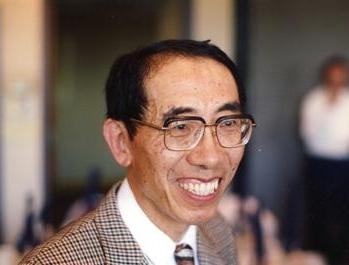

|

|
IN MEMORIAM
Shoshichi Kobayashi
Professor of Mathematics, Emeritus
UC Berkeley
1932-2012
Shoshichi Kobayashi died peacefully in his sleep on August 29, 2012.
Shoshichi, the first of five sons of Kyuzo and Yoshie Kobayashi, was born on January 4th, 1932 in Kofu City, Yamanashi Prefecture, Japan. He received his high school education at the Number One Higher School (called “Daiichi Koto Gakko” or “Ikko” for short) in Tokyo, the most difficult Higher School to get into.
After finishing at Ikko, which had become the Junior College of the University of Tokyo (called “Todai”), Shoshichi continued at Todai itself, graduating in 1953. Almost every day after his classes at Todai he attended French language classes at Athenée Français and Institut français du Japon, arriving home after the family had finished dinner. Those studies paid off with a scholarship from the French Government for graduate studies in France for a year at mathematics institutes in Paris and Strasbourg. In 1954, he moved to the University of Washington in Seattle, where he received his PhD in less than two years at age 24. He then spent two years at the Institute for Advanced Study, two years at MIT, and two years at the University of British Columbia in Vancouver before joining the Berkeley faculty in 1962 as an assistant professor. He was awarded tenure the following year and was promoted to full professor in 1966. He served as chair of the Department of Mathematics from 1978 to 1981 and again for the Fall Semester in 1992. He retired under the Voluntary Early Retirement Incentive Program (VERIP) in 1994, remaining in Berkeley most of the time but making frequent visits to Keio University’s undergraduate campus at Hiyoshi which houses the graduate school of science and technology.
In the spring of 1956, the studious Shoshichi surprised his family by announcing that he was going to marry Ms. Yukiko Grace Ashizawa. The marriage took place in 1957. Together, Shoshichi and Grace contributed immensely to a congenial spirit among his colleagues, many of whom also knew well their daughters Sumire and Mei. (Mei eventually went on to receive a PhD in Mathematics from Berkeley.)
When Sho (as he was known to friends and colleagues) was asked in 1978, under intense pressure, to allow his name to be entered among the candidates in a poll of faculty choices for Chair, he reluctantly granted permission, believing there was no possible way he would be a popular choice. Later, while vacationing in Europe, he was reportedly shocked and horrified to receive a cable that he was to be the new Chair. But Sho rose to the challenge and performed admirably in his new role. He is perhaps best remembered from his chairmanship as the man, perceived by many as quiet, shy, and meek, who produced a fierce (and successful) defense in the “Space Wars” which ensued when the campus tried to take away some of the Department's heavily used space allotment. This earned him the fitting sobriquet “Tiger Kobayashi”.
Sho has left a most impressive mathematical legacy in the form of a roster of 35 PhD students, a long list of contributions to differential geometry, and many influential monographs. Among the honors and awards which he received over the course of his career were: Sloan Fellowship, Guggenheim Fellowship, JSPS Fellowship, Geometry Prize of the Mathematical Society of Japan, and Humboldt Prize.
Perhaps the most well-known mathematical object bearing his name is the “Kobayashi pseudometric,” which he introduced in 1967. Despite a name which makes it sound like something fake, this is a real measure of distance which quickly became in Sho’s hands, and remains throughout the mathematical world, an essential tool for the study of mappings between and within complex manifolds. The “pseudo” refers to the fact that, in some spaces, two different points could have zero distance between them. Sho identified the absence of this undesirable property as one which characterized certain “good” spaces which he called “hyperbolic” and which are now known as “Kobayashi hyperbolic”.
Sho worked in many areas of differential geometry, but he concentrated in the area of complex geometry, where he made a string of fundamental contributions throughout a career of over fifty years. One of the most influential was the conjecture of what is now known as the “Kobayashi-Hitchin correspondence”, asserting an equivalence between algebraic-geometric and differential-geometric properties of complex vector bundles.
From early in his career, Sho actively supported women in mathematics. He was an early member of the Association for Women in Mathematics. Among his 35 PhD students were five women, a number which is still (unfortunately) quite large for faculty members in almost any mathematics department in the US and most other countries. He was also very supportive as a mentor to young women faculty and, more recently, to women students in Japan.
Sho was a master of mathematical communication. He even wrote (in Japanese) a paper called “How to write a mathematical paper in English.” More important, his books, especially the two-volume Foundations of Differential Geometry with Katsumi Nomizu, have taught differential geometry and complex geometry to generations of students and other researchers. Shortly before his death, he completed a series of essays (in Japanese) which were published in July 2013 by Iwanami Shoten under the title Mathematicians Who Lost Their Faces—Essays in Idleness on Mathematics.
Shoshichi Kobayashi is survived by his wife Yukiko (Grace), daughter Sumire and son-in-law Phil Chou, daughter Mei, and grandsons Andrew and Brendan. He is also survived by his brothers Toshinori and Hisashi.
Much more material about Shoshichi Kobayashi's life and work may be found at http://www.shoshichikobayashi.com/.
Alan Weinstein
John Addison
Robert Bryant